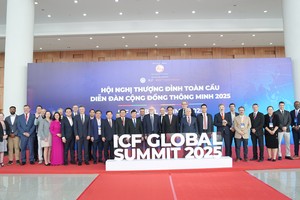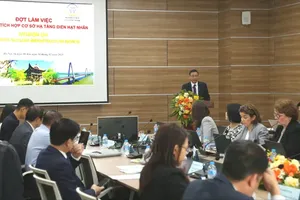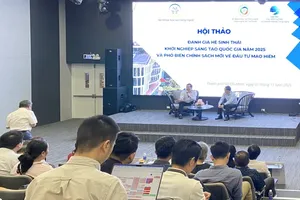
The event convened experts and officials to discuss strategies for leveraging the digital economy to achieve sustainable development.
Ho Chi Minh City to replicate two proven digital economy models
In his opening remarks, Director Lam Dinh Thang of the Department of Science and Technology underscored the need for a transformative growth model for the newly merged megacity. He highlighted the digital economy as the core driving force, emphasizing the city’s strengths, including its significant economic scale and population, a diverse economic ecosystem, and a robust digital infrastructure. Director Lam Dinh Thang noted that HCMC also benefits from a large digital consumer market and a skilled workforce.
Despite these advantages, challenges remain, including a lack of harmonized policies, difficulties in attracting and retaining high-quality human resources, and the need for enhanced cybersecurity and data protection measures. To address these issues, the city has strategically prioritized the development of its digital economy.
HCMC has set ambitious targets for this sector, aiming for the digital economy to contribute 25 percent of its Gross Regional Domestic Product (GRDP) by 2025, with a further increase to over 40 percent by 2030. According to Associate Professor Tran Minh Tuan, Director of the Department of Digital Economy - Digital Society at the Ministry of Science and Technology, the proportion of the digital economy to GRDP for the merged HCMC currently stands at approximately 21 percent.
Associate Professor Tran Minh Tuan cited two successful digital economy models implemented in Ho Chi Minh City in 2024.
The first is the pilot model of digital transformation in wholesale and retail trade in Phu Nhuan District. In the food service sector, this initiative reduced operating costs by 16 percent and increased profits by 15 percent–30 percent. For retail stores, costs fell by 25 percent, while the number of new customers rose by 25 percent–35 percent.
The second is the smart production model adopted at the Orion Vina Factory in Binh Duong Province. This model boosted production capacity by 30 percent, reduced machine downtime by 68 percent, cut inspection costs by 50 percent, and generated an economic benefit of US$19 million within eight months.
According to the Ministry of Science and Technology, both models will be studied and replicated nationwide. Leaders of the Department of Digital Economy and Digital Society commended Ho Chi Minh City for prioritizing digital transformation as a strategic driver toward achieving double-digit growth. They affirmed that focusing on the digital economy is a sound and forward-looking development strategy for the city.
Supporting businesses in digital transformation
According to Associate Professor Tran Minh Tuan, it is imperative to accelerate the digital transformation of small and medium-sized enterprises (SMEs) to enhance labor productivity and promote the development of Ho Chi Minh City’s digital economy. Globally, emerging technologies such as Artificial Intelligence (AI), the Internet of Things (IoT), Blockchain, and Digital Twin have significantly improved labor productivity.
Currently, Vietnam’s labor productivity remains modest—only 7.2 percent that of Singapore, 22.4 percent of Malaysia, 38.3 percent of Thailand, and 56.8 percent of Indonesia. Despite this gap, the level of digital transformation among domestic enterprises remains low. A recent survey found that while 30 percent–40 percent of SMEs have implemented some form of digital transformation, 69 percent operate only at a basic application level, such as using email or simple accounting software. Additionally, 62 percent of businesses lack personnel with digital skills, 55 percent face limited financial capacity to invest in technology, and 37 percent are uncertain about how to begin the transformation process.
Associate Professor Tran Minh Tuan proposed that the State should allocate resources from the National Technology Innovation Fund (NATIF) to support enterprise-level digital transformation, drawing inspiration from the models adopted by Singapore and China.
On June 30, the Ministry of Science and Technology issued a decision establishing a set of criteria for assessing the digital transformation maturity of businesses. This framework will evaluate enterprises in 25 sectors through both general and industry-specific questions, classifying them into five levels: Start-up, Departure, Acceleration, Optimization, and Elite. Participating businesses will receive support in developing digital solutions and adopting advanced technologies, with the condition that these solutions must demonstrate at least a 15 percent increase in labor productivity. Each enterprise will also be assigned an electronic profile-updated in real time-serving as a ‘digital transformation resume’. The toolkit is scheduled for completion in the third quarter of 2025.
Regarding human capital for the digital economy, Vice Principal Thai Kim Phung of the School of Technology and Design (University of Economics Ho Chi Minh City – UEH) noted that Ho Chi Minh City was historically the largest and highest-quality center for digital human resources but now faces mounting pressure to meet demand for specialized skills. Binh Duong has advantages in scale and infrastructure, yet its human resource quality remains weak and requires urgent improvement. Ba Ria–Vung Tau excels in training and in the proportion of qualified workers but lags in practical application and specialized digital skills.
Vice Principal Thai Kim Phung suggested that, in the short term, priority should be given to short-course training and upskilling programs for existing workers. In the long term, the establishment of regional innovation and digital skills centers in Ho Chi Minh City and its satellite areas such as Thu Dau Mot and Vung Tau should be pursued. These hubs would serve as focal points for training, research, and the practical application of digital technologies.
Speaking at the workshop, UEH Director Professor Su Dinh Thanh emphasized that in positioning the digital economy as a new growth driver for Ho Chi Minh City, it is essential to identify which digital products generate the greatest added value for both the local and broader economy. This issue, he noted, requires further detailed analysis by all stakeholders.
























